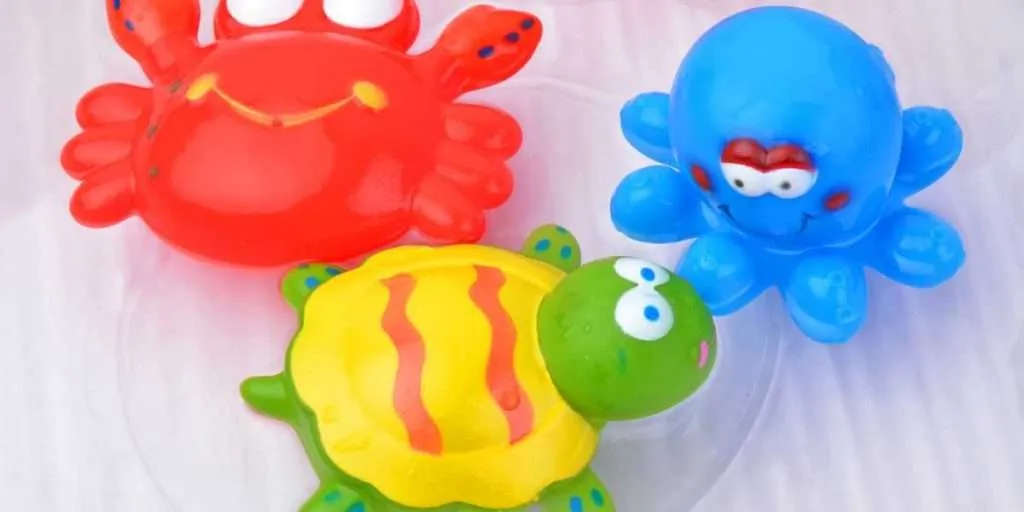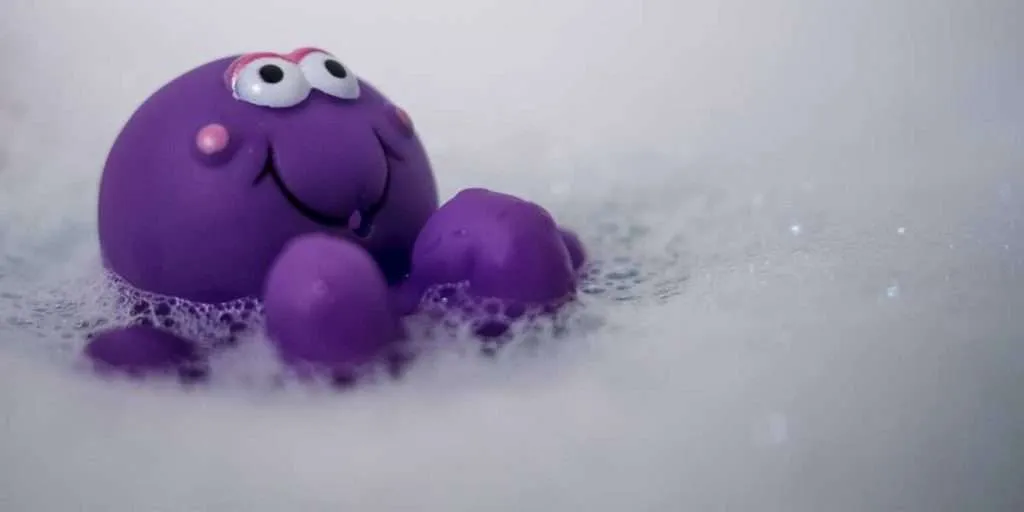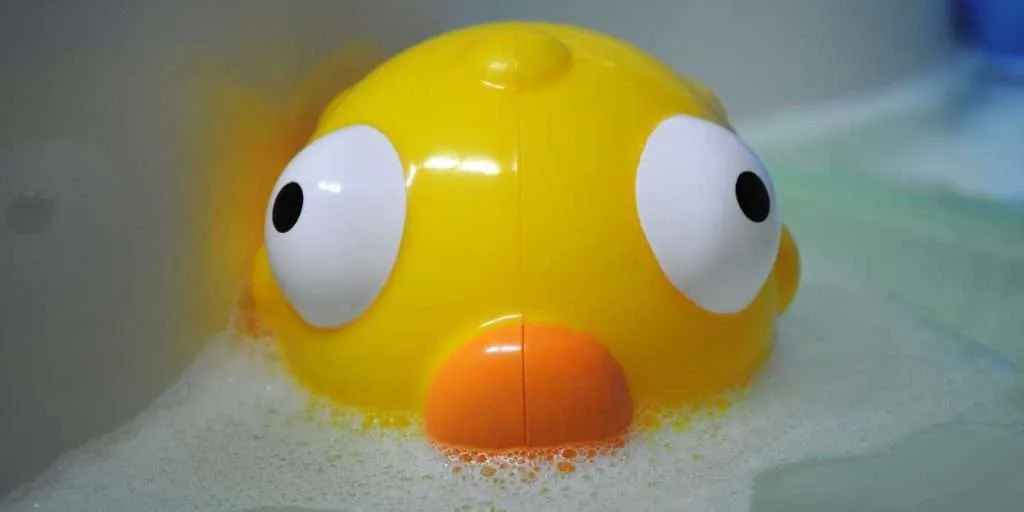Addressing How to Keep Bath Toys From Getting Mouldy is a priority for parents keen on maintaining a hygienic play environment during bath time. In the moist surroundings of a bathroom, bath toys can easily become breeding grounds for mold and mildew.
Bath toys, especially those with hidden cavities, are susceptible to moisture retention, which can lead to mold growth. But with proactive measures, you can prevent this from happening. This guide will present step-by-step methods to ensure your bath toys remain clean, dry, and mold-free, safeguarding your child’s health and the longevity of the toys.
Wish to ensure bath time remains both fun and hygienic? Join us as we navigate effective strategies to ward off unwanted mold from your child’s favorite bath toys.
Key Takeaways: How to Keep Bath Toys From Getting Mouldy
- Proper Drainage:
- Holes and Vents: If possible, avoid bath toys with holes that can trap water inside. If they do have holes, ensure they’re emptied completely after each use.
- Netted Storage: Use mesh or netted storage bags that allow toys to drain and air out. These bags can be hung on bathroom hooks or suction cups.
- Regular Cleaning:
- Vinegar Solution: Mix equal parts of white vinegar and water in a large container. Soak the toys in this solution for about an hour, then scrub lightly and rinse with fresh water.
- Bleach Solution: For a deeper clean, soak toys in a solution of 1 gallon of water with ¾ cup of bleach for 5 minutes. Rinse thoroughly afterward.
- Drying After Each Use:
- Towel Dry: After each bath, take a few moments to rinse and towel dry the toys. This removes soap residue and helps prevent mold.
- Air Out: Allow the toys to air dry completely in a well-ventilated area.
- Regular Inspections:
- Check for Mold: Periodically inspect bath toys for signs of mold or black spots. If you spot mold on a toy that can’t be cleaned thoroughly, it’s best to discard it.
- Seal Holes:
- Hot Glue: If you have squeeze toys with holes, consider sealing them with hot glue. This prevents water from getting inside, reducing the risk of mold.
- Rotate Toys:
- Limit Exposure: Instead of using all the bath toys every time, rotate them. This gives each set of toys a chance to dry out completely between uses.
- Storage Location:
- Avoid Humid Areas: Store bath toys outside of the bathroom if possible, or in an area of the bathroom where there’s less humidity.
- Replace Regularly:
- Lifespan: Even with proper care, bath toys have a limited lifespan. Consider replacing them periodically, especially if they start to look worn or discolored.
- Natural Solutions:
- Tea Tree Oil: A few drops of tea tree oil in the cleaning water can act as a natural mold inhibitor due to its antifungal properties.
Quick Summary on Cleaning Bath toys
| Step | Instructions |
|---|---|
| 1. Gather Supplies | You’ll need white vinegar, water, a bucket or basin, an old toothbrush or scrub brush, and a towel. |
| 2. Prepare a Vinegar Solution | Mix equal parts of white vinegar and warm water in a bucket or basin. The vinegar acts as a natural disinfectant. |
| 3. Soak the Toys | Submerge the bath toys in the vinegar solution and let them soak for 1-2 hours. This will help loosen any mold or soap scum. |
| 4. Scrub | After soaking, use the toothbrush or scrub brush to scrub the toys, paying special attention to crevices and holes where mold can hide. |
| 5. Rinse Thoroughly | Rinse each toy under warm water to remove any vinegar residue. |
| 6. Squeeze Out Excess Water | If the toys have holes (like rubber ducks), squeeze out as much water as possible to prevent mold growth inside. |
| 7. Air Dry | Lay the toys out on a clean towel in a well-ventilated area to air dry. Ensure they are completely dry before storing to prevent mold growth. |
| 8. Regular Maintenance | To prevent mold and mildew, squeeze out excess water from toys after each bath and allow them to air dry. |
| 9. Storage | Store bath toys in a mesh bag or a storage container with drainage holes to ensure they continue to dry between uses. |
| 10. Regular Cleaning | Repeat the cleaning process every few weeks or more often if you notice any mold or if the toys start to develop a musty odor. |
Preventing Mold in Bath Toys
Mold can grow on bath toys when they are not properly cleaned and dried after use. Here are some tips to prevent mold from growing on your child’s bath toys:
- Seal the holes: Bath toys with holes can allow water to get inside and create a breeding ground for mold. To prevent this, seal the holes with hot glue or silicone caulk. Make sure to cover the holes completely and let the sealant dry completely before using the toy again.
- Use a bathroom exhaust fan: If you have a bathroom exhaust fan, turn it on during and after bath time to help remove excess moisture from the air. This will help prevent mold from growing on the toys and other surfaces in the bathroom.
- Ensure proper ventilation: Proper ventilation is important in preventing mold growth. Keep the bathroom door open and a window cracked to allow fresh air to circulate and help dry out the bathroom.
- Store toys properly: After bath time, make sure to store the toys in a dry and well-ventilated area. Avoid storing them in a closed container or toy net, as this can trap moisture and promote mold growth.
By following these tips, you can help prevent mold from growing on your child’s bath toys and keep them clean and safe for use.

Cleaning Bath Toys in the Dishwasher
Did you know that you can clean your child’s bath toys in the dishwasher?
Yes, you read that right!
This is a quick and easy way to clean them, and it’s also an effective way to kill bacteria and germs.
However, not all bath toys are dishwasher safe, so it’s important to check the label before you put them in.
To clean bath toys in the dishwasher, simply place them on the top rack of the dishwasher.
Hand Cleaning Bath Toys
Cleaning bath toys by hand is a simple and effective way to ensure they are free of germs and bacteria. Here are some steps to follow:
- Start by filling a sink or basin with warm water and a small amount of dish soap.
- Add a half cup of white vinegar to the water to help kill any bacteria or mold that may be present on the toys.
- Place the toys in the water and use a toothbrush to scrub them thoroughly. Pay special attention to any crevices or small holes where water may be trapped.
- Rinse the toys thoroughly with clean water to remove any soap or vinegar residue.
- If you notice any stubborn stains or buildup, you can use a mixture of one part bleach to ten parts water to disinfect the toys. Be sure to wear rubber gloves and use tongs to handle the toys.
- After cleaning, place the toys on a rack to air dry.
By following these simple steps, you can keep your child’s bath toys clean and free of harmful germs and bacteria.

Disinfecting Bath Toys
Bath toys are great for keeping your little ones entertained during bath time, but they can also harbor harmful bacteria and mold. Disinfecting your child’s bath toys is an essential step in maintaining a clean and healthy bathroom. Here are some effective ways to disinfect bath toys:
Bleach
Bleach is a powerful disinfectant that can kill germs and bacteria on bath toys. To disinfect bath toys with bleach, add 1/2 cup of regular bleach per gallon of water and soak the toys for 10 minutes in the tub. Rinse the toys thoroughly with water and let them air dry. Be sure to use caution when handling bleach and keep it out of reach of children.
Vinegar
Vinegar is a natural disinfectant that can help kill germs and bacteria on bath toys. Mix a solution of 1 part white vinegar to 3 parts water and soak the toys for at least 15 minutes. Rinse the toys thoroughly with water and let them air dry.
Hydrogen Peroxide
Hydrogen peroxide is another natural disinfectant that can be used to clean bath toys. Mix a solution of 1 part hydrogen peroxide to 2 parts water and soak the toys for at least 30 minutes. Rinse the toys thoroughly with water and let them air dry.
Milton Sterilizing Fluid
Milton Sterilizing Fluid is a popular disinfectant that is safe for use on bath toys. Mix a solution of 1 part Milton Sterilizing Fluid to 5 parts water and soak the toys for at least 15 minutes. Rinse the toys thoroughly with water and let them air dry.
Boiling Water
Boiling water is an effective way to kill germs and bacteria on bath toys. Fill a pot with water and bring it to a boil. Submerge the toys in the boiling water for at least 5 minutes. Remove the toys from the water and let them air dry.
Disinfectant Wipes
Disinfectant wipes are a convenient way to clean bath toys. Simply wipe down the toys with a disinfectant wipe and let them air dry. Be sure to use wipes that are safe for use on children’s toys.

Storing Bath Toys After Cleaning to keep bath toys from molding
After cleaning your child’s bath toys, it’s important to store them properly to avoid any mold or mildew growth. Here are some tips on how to store bath toys:
Use a Toy Organizer
A toy organizer is a great way to store bath toys. You can find them in a variety of sizes and shapes, and they’re designed to keep toys dry and organized. Look for one with drainage holes to allow water to drain out and prevent mold growth.
Hang Them Up
If you don’t have space for a toy organizer, consider hanging your child’s bath toys up to dry. You can use a suction cup hook or a command hook to hang them on the shower wall or on the side of the tub. Make sure to hang them up high enough so they’re out of reach of your child.
Use a Rack
If you have a lot of bath toys, consider using a rack to store them. A rack can be placed on the side of the tub or on a shelf, and it’s a great way to keep toys organized and dry. Look for a rack with drainage holes to allow water to drain out.
Store Them in a Dry Place
After bath time, make sure to store your child’s bath toys in a dry place. Avoid storing them in a damp bathroom or in a closed container, as this can lead to mold growth. If you have a bathroom exhaust fan, turn it on after bath time to help remove moisture from the air.

Choosing your toys to prevent Mold
There’s no denying that some toys are more likely to get mouldy than others. Squirty toys being the hardest to keep mould free. They have a tiny hole so even with the best will in the world it’s hard to get all the moisture out, and they are generally opaque meaning it stays nice and dark inside, perfect for mould.
The easiest option is to seal them up with a hot glue gun when you first get them. But of course, that means they don’t squirt anymore. And you don’t want to seal up toys that are already mouldy. You can also cut a larger hole to make it possible to scrub inside.
But getting rid of squirty toys doesn’t mean your bath time has to be either rubber duck free or squirt free. You can get some amazing rubber toys that don’t have holes in them including ducks and other things. And an old Calpol syringe or a bottle with a hole in the lid offers plenty of opportunities for squirting each other.
Foam bath toys also tend to be prime culprits for mould for the fact that foam is very porous and they take much longer to dry than hard plastic toys. Again you can simply avoid these toys or make sure you clean them regularly.
Hard plastic toys on the other hand like the Green Toys range made from recycled milk bottles and natural rubber toys that don’t have holes are the easiest to keep mould free as they are easy to rinse and dry after a bath.
Frequently Asked Questions On how to stop bath toys going mouldy
What is the best way to clean baby’s bath toys?
The best way to clean bath toys is to use a mixture of warm water and mild soap. You can also do a toys soak in mixture of water and vinegar to remove any mold or mildew. Some people prefer to clean their bath toys in the dishwasher, but be sure to check the manufacturer’s instructions to make sure the toys are dishwasher safe.
How often should I clean baby bath toys?
It is recommended to clean your kids bath toys at least once a week. However, if you notice any mold or mildew on the toys, you should clean them immediately. Regular cleaning will help prevent the growth of mold and bacteria.
How do I disinfect bath toys without bleach?
If you prefer to avoid using bleach solution, you can disinfect bath toys and clean bath toys safely using vinegar or hydrogen peroxide. To use vinegar, mix equal parts water and vinegar and soak the toys for at least 10 minutes. Rinse the toys with water and let them air dry. To use hydrogen peroxide, mix equal parts water and hydrogen peroxide and soak the toys for at least 30 minutes. Rinse the toys with water and let them air dry.
How do I remove mold from bath toys?
To remove mold from bath toys, mix equal parts water and vinegar and soak the toys for at least 10 minutes. Scrub the toys with a soft-bristled brush to remove any remaining mold. Rinse the toys with water and let them air dry. If the mold is stubborn, you can also try soaking the toys in a mixture of water and hydrogen peroxide for 30 minutes.
How long should I soak bath toys in vinegar?
To clean and disinfect children’s bath toys using vinegar, you should soak the toys in a mixture of equal parts hot water and vinegar for at least 10 minutes. After soaking, rinse the toys with water and let them air dry.
Can mold on bath toys make you sick?
Yes, mold on baby toys can make you sick. Mold can cause respiratory problems, allergies, and other health issues. It is important to clean and disinfect bath toys regularly to prevent the growth of mold and bacteria. It is a particular problem with squirting toys and their tiny holes
so ensure that all water is drained out from inside bath toys after the bath and hung to dry in a mesh laundry bag.





